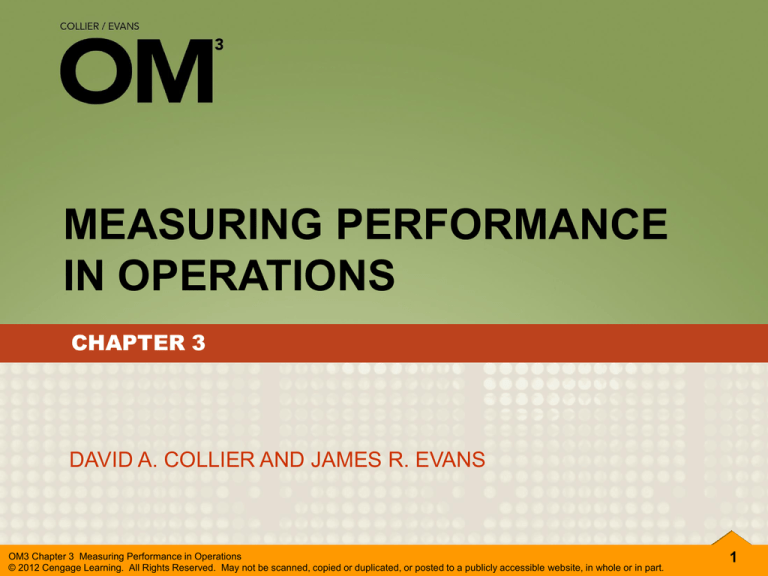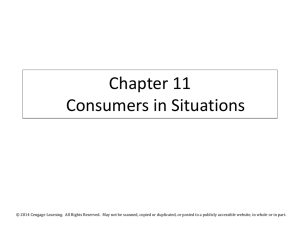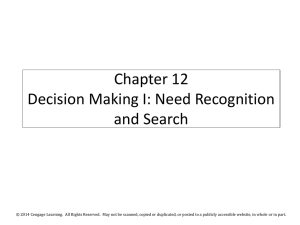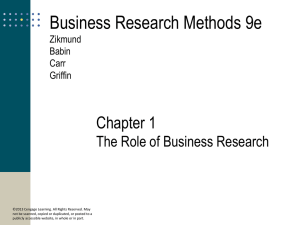
MEASURING PERFORMANCE
IN OPERATIONS
CHAPTER 3
DAVID A. COLLIER AND JAMES R. EVANS
OM3 Chapter 3 Measuring Performance in Operations
© 2012 Cengage Learning. All Rights Reserved. May not be scanned, copied or duplicated, or posted to a publicly accessible website, in whole or in part.
1
CHAPTER 3
MEASURING PERFORMANCE IN OPERATIONS
LO1 Describe the types of measures used for decision
making.
LO2 Explain how to calculate and use productivity
measures.
LO3 Explain how internal and external measures are
related.
LO4 Explain how to design a good performance
measurement system.
LO5 Describe four models of organizational
performance.
OM3 Chapter 3 Measuring Performance in Operations
© 2012 Cengage Learning. All Rights Reserved. May not be scanned, copied or duplicated, or posted to a publicly accessible website, in whole or in part.
2
i
CHAPTER 3
MEASURING PERFORMANCE IN OPERATIONS
magine entering the cockpit of a modern jet airplane and seeing only
a single instrument there. How would you feel about boarding the
plane after the following conversation with the pilot?
Passenger: I’m surprised to see you operating the plane with only a single
instrument. What does it measure?
Pilot: Airspeed. I’m really working on airspeed this flight.
Passenger: That’s good. Airspeed certainly seems important. But what
about altitude? Wouldn’t an altimeter be helpful?
Pilot: I worked on altitude for the last few flights and I’ve gotten pretty
good on it. Now I have to concentrate on proper airspeed.
Passenger: But I notice you don’t even have a fuel gauge. Wouldn’t that be
useful?
Pilot: You’re right; fuel is significant, but I can’t concentrate on doing too
many things well at the same time. So on this flight I’m focusing on airspeed.
Once I get to be excellent at airspeed, as well as altitude, I intend to
concentrate on fuel consumption on the next set of flights.
OM3 Chapter 3 Measuring Performance in Operations
© 2012 Cengage Learning. All Rights Reserved. May not be scanned, copied or duplicated, or posted to a publicly accessible website, in whole or in part.
3
CHAPTER 3
MEASURING PERFORMANCE IN OPERATIONS
What do you think?
What measures do you
use to evaluate a
company’s goods or
services? Provide
some examples.
OM3 Chapter 3 Measuring Performance in Operations
© 2012 Cengage Learning. All Rights Reserved. May not be scanned, copied or duplicated, or posted to a publicly accessible website, in whole or in part.
4
CHAPTER 3
MEASURING PERFORMANCE IN OPERATIONS
Measurement is the act of quantifying the
performance criteria (metrics) of organizational
units, goods and services, processes, people, and
other business activities.
Good measures provide a “scorecard” of
performance, help identify performance gaps, and
make accomplishments visible to the workforce,
the stock market, and other stakeholders.
OM3 Chapter 3 Measuring Performance in Operations
© 2012 Cengage Learning. All Rights Reserved. May not be scanned, copied or duplicated, or posted to a publicly accessible website, in whole or in part.
5
CHAPTER 3
MEASURING PERFORMANCE IN OPERATIONS
Types of Performance Measures
Important categories of organizational
performance measures:
• Financial
• Customer and Market
• Quality
•
•
•
•
Time
Flexibility
Innovation and Learning
Sustainability
OM3 Chapter 3 Measuring Performance in Operations
© 2012 Cengage Learning. All Rights Reserved. May not be scanned, copied or duplicated, or posted to a publicly accessible website, in whole or in part.
6
CHAPTER 3
MEASURING PERFORMANCE IN OPERATIONS
Exhibit 3.1 The Scope of Business and Operations Performance Measurement
OM3 Chapter 3 Measuring Performance in Operations
© 2012 Cengage Learning. All Rights Reserved. May not be scanned, copied or duplicated, or posted to a publicly accessible website, in whole or in part.
7
CHAPTER 3
MEASURING PERFORMANCE IN OPERATIONS
Financial Measures
•
Often take top priority in for-profit organizations.
•
Traditional financial measures include revenue,
return on investment, operating profit, pretax
profit margin, asset utilization, growth, revenue
from new goods and services, earnings per
share, and other liquidity measures.
OM3 Chapter 3 Measuring Performance in Operations
© 2012 Cengage Learning. All Rights Reserved. May not be scanned, copied or duplicated, or posted to a publicly accessible website, in whole or in part.
8
CHAPTER 3
MEASURING PERFORMANCE IN OPERATIONS
Customer and Market Measures
• Customer measures: Customer satisfaction, customer
retention, gains and losses of customers and customer
accounts, customer complaints, warranty claims,
measures of perceived value, loyalty, positive referral, and
customer relationship building.
− A customer-satisfaction measurement system
provides a company with customer ratings of specific goods
and service features, and indicates the relationship
between those ratings and the customer’s likely future
buying behavior.
• Market measures: Market share, business growth, new
product and geographic markets entered, percentage of
new product sales.
OM3 Chapter 3 Measuring Performance in Operations
© 2012 Cengage Learning. All Rights Reserved. May not be scanned, copied or duplicated, or posted to a publicly accessible website, in whole or in part.
9
CHAPTER 3
MEASURING PERFORMANCE IN OPERATIONS
OM3 Chapter 3 Measuring Performance in Operations
© 2012 Cengage Learning. All Rights Reserved. May not be scanned, copied or duplicated, or posted to a publicly accessible website, in whole or in part.
10
CHAPTER 3
MEASURING PERFORMANCE IN OPERATIONS
Quality
• Quality measures the degree to which the
output of a process meets customer
requirements.
• Goods quality relates to the physical
performance and characteristics of a good.
• Service quality is consistently meeting or
exceeding customer expectations (external
focus) and service delivery system performance
(internal focus) for all service encounters.
OM3 Chapter 3 Measuring Performance in Operations
© 2012 Cengage Learning. All Rights Reserved. May not be scanned, copied or duplicated, or posted to a publicly accessible website, in whole or in part.
11
CHAPTER 3
MEASURING PERFORMANCE IN OPERATIONS
Service Quality Dimensions
1. Tangibles—physical facilities, uniforms, equipment,
vehicles, and appearance of employees (i.e., the physical
evidence).
2. Reliability—ability to perform the promised service
dependably and accurately.
3. Responsiveness—willingness to help customers and
provide prompt recovery to service upsets.
4. Assurance—knowledge and courtesy of the serviceproviders, and their ability to inspire trust and confidence
in customers.
5. Empathy—caring attitude and individualized attention
provided to its customers.
OM3 Chapter 3 Measuring Performance in Operations
© 2012 Cengage Learning. All Rights Reserved. May not be scanned, copied or duplicated, or posted to a publicly accessible website, in whole or in part.
12
CHAPTER 3
MEASURING PERFORMANCE IN OPERATIONS
Service Quality
•
Every service encounter provides an
opportunity for error.
• Errors in service creation and delivery are
sometimes called service upsets or
service failures.
OM3 Chapter 3 Measuring Performance in Operations
© 2012 Cengage Learning. All Rights Reserved. May not be scanned, copied or duplicated, or posted to a publicly accessible website, in whole or in part.
13
CHAPTER 3
MEASURING PERFORMANCE IN OPERATIONS
Time
•
Time relates to two types of performance
measures:
1. the speed of doing something
2. the variability of the process
• Processing time is the time it takes to perform
some task.
• Queue time is a fancy word for wait time—the
time spent waiting.
OM3 Chapter 3 Measuring Performance in Operations
© 2012 Cengage Learning. All Rights Reserved. May not be scanned, copied or duplicated, or posted to a publicly accessible website, in whole or in part.
14
CHAPTER 3
MEASURING PERFORMANCE IN OPERATIONS
OM3 Chapter 3 Measuring Performance in Operations
© 2012 Cengage Learning. All Rights Reserved. May not be scanned, copied or duplicated, or posted to a publicly accessible website, in whole or in part.
15
CHAPTER 3
MEASURING PERFORMANCE IN OPERATIONS
Flexibility
• Flexibility is the ability to adapt quickly and effectively to
changing requirements.
• Goods and service design flexibility is the ability to
develop a wide range of customized goods and services to
meet different or changing customer needs.
−
Measures include the rate of new product development or percent
of product mix developed over the past three years.
• Volume flexibility is the ability to respond quickly to
changes in the volume and type of demand.
−
Measures include the time to change machine setups or time
required to “ramp up” to an increased production volume.
OM3 Chapter 3 Measuring Performance in Operations
© 2012 Cengage Learning. All Rights Reserved. May not be scanned, copied or duplicated, or posted to a publicly accessible website, in whole or in part.
16
CHAPTER 3
MEASURING PERFORMANCE IN OPERATIONS
Innovation and Learning
• Innovation refers to the ability to create new and
unique goods and services that delight customers and
create competitive advantage.
• Learning refers to creating, acquiring, and transferring
knowledge, and modifying the behavior of employees in
response to internal and external change.
•
Measures of innovation and learning include intellectual
asset growth, patent applications, best practices
implemented, new product development, employee
training and skills development, satisfaction, work
system performance and effectiveness.
OM3 Chapter 3 Measuring Performance in Operations
© 2012 Cengage Learning. All Rights Reserved. May not be scanned, copied or duplicated, or posted to a publicly accessible website, in whole or in part.
17
CHAPTER 3
MEASURING PERFORMANCE IN OPERATIONS
Sustainability
• The Triple bottom line (TBL or 3BL) refers to the
measurement of environmental, social, and economic
sustainability.
− Environmental sustainability measures include
energy consumption, recycling, air emissions, solid and
hazardous waste rates.
− Social sustainability measures include consumer and
workplace safety, community relations, corporate ethics
and governance, and ethical violations.
− Economic sustainability measures include financial
audit results, regulatory compliance, sanctions and fines,
and accomplishment of strategic initiatives.
OM3 Chapter 3 Measuring Performance in Operations
© 2012 Cengage Learning. All Rights Reserved. May not be scanned, copied or duplicated, or posted to a publicly accessible website, in whole or in part.
18
CHAPTER 3
MEASURING PERFORMANCE IN OPERATIONS
Productivity
Productivity is the ratio of output of a process to
the input
Productivity =
Quantity of Output
Quantity of Input
[3.1]
Productivity measures include units produced/labor hour,
airline revenue per passenger mile, meals served/labor
dollar.
OM3 Chapter 3 Measuring Performance in Operations
© 2012 Cengage Learning. All Rights Reserved. May not be scanned, copied or duplicated, or posted to a publicly accessible website, in whole or in part.
19
CHAPTER 3
MEASURING PERFORMANCE IN OPERATIONS
Linking Internal and External Performance
Measures
•
Managers must understand the cause and
effect linkages between key measures of
performance. These relationships often explain
the impact of operational performance on
external results.
• The quantitative modeling of cause and effect
relationships between external and internal
performance criteria is called interlinking.
OM3 Chapter 3 Measuring Performance in Operations
© 2012 Cengage Learning. All Rights Reserved. May not be scanned, copied or duplicated, or posted to a publicly accessible website, in whole or in part.
20
CHAPTER 3
MEASURING PERFORMANCE IN OPERATIONS
Exhibit 3.2 Interlinking Internal and External Performance Measures
OM3 Chapter 3 Measuring Performance in Operations
© 2012 Cengage Learning. All Rights Reserved. May not be scanned, copied or duplicated, or posted to a publicly accessible website, in whole or in part.
21
CHAPTER 3
MEASURING PERFORMANCE IN OPERATIONS
Linking Internal and External Performance
Measures
• The value of a loyal customer (VLC)
quantifies the total revenue or profit each
target market customer generates over the
buyer’s life cycle.
•
By multiplying the VLC times the absolute
number of customers gained or lost, the total
market value can be found.
OM3 Chapter 3 Measuring Performance in Operations
© 2012 Cengage Learning. All Rights Reserved. May not be scanned, copied or duplicated, or posted to a publicly accessible website, in whole or in part.
22
CHAPTER 3
MEASURING PERFORMANCE IN OPERATIONS
Solved Problem – Value of Loyal Customer
What is the value of a loyal customer (VLC) in the small
contractor target market segment who buys an electric drill
on average every 4 years or 0.25 years for $100, when the
gross margin on the drill averages 50 percent, and the
customer retention rate is 60 percent? What if the customer
retention rate increases to 80 percent?
What is a 1 percent change in market share worth to the
manufacturer if it represents 100,000 customers? What do
you conclude?
OM3 Chapter 3 Measuring Performance in Operations
© 2012 Cengage Learning. All Rights Reserved. May not be scanned, copied or duplicated, or posted to a publicly accessible website, in whole or in part.
23
CHAPTER 3
MEASURING PERFORMANCE IN OPERATIONS
Solution
If customer retention rate is 60 percent, the average customer
defection rate = (1 – customer retention rate). Thus, the customer
defection rate is 40 percent, or 0.4. The average buyer’s life cycle
is 1/0.4 = 2.5 years. The repurchase frequency is every four
years, or 0.25 (1.4).
Therefore:
VLC (P)(RF)(CM)(BLC) =
($100)(0.25)(0.50)(1/0.4) = $31.25 over the buyer’s life cycle
The value of a 1 percent change in market share =
(100,000 customers)($31.25/customer) = $3,125,000
OM3 Chapter 3 Measuring Performance in Operations
© 2012 Cengage Learning. All Rights Reserved. May not be scanned, copied or duplicated, or posted to a publicly accessible website, in whole or in part.
24
CHAPTER 3
MEASURING PERFORMANCE IN OPERATIONS
Solution (continued):
If customer retention rate is 80 percent, the average customer
defection rate is 0.2, and the average buyer’s life cycle is 1/0.2 =
5 years.
Then:
VLC (P)(RF)(CM)(BLC) =
($100)(0.25)(0.50)(1/.2) = $62.50
Thus, the value of a 1 percent change in market share
(100,000 customers)($62.50/customer/year) = $6,250,000
The economics are clear. If customer retention can be increased
from 60 to 80 percent through better value chain performance,
the economic payoff is doubled.
OM3 Chapter 3 Measuring Performance in Operations
© 2012 Cengage Learning. All Rights Reserved. May not be scanned, copied or duplicated, or posted to a publicly accessible website, in whole or in part.
25
CHAPTER 3
MEASURING PERFORMANCE IN OPERATIONS
Designing Measurement Systems in Operations
Key Questions:
• Does the measurement support our mission?
• Will the measurement be used to manage change?
• Is it important to our customers?
• Is it effective in measuring performance?
• Is it effective in forecasting results?
• Is it easy to understand/simple?
• Is the data easy/cost-efficient to collect?
• Does the measurement have validity, integrity, and
timeliness?
• Does the measurement have an owner?
OM3 Chapter 3 Measuring Performance in Operations
© 2012 Cengage Learning. All Rights Reserved. May not be scanned, copied or duplicated, or posted to a publicly accessible website, in whole or in part.
26
CHAPTER 3
MEASURING PERFORMANCE IN OPERATIONS
Designing Measurement Systems in Operations
Good performance measures are actionable.
Actionable measures provide the basis for
decisions at the level at which they are applied—the
value chain, organization, process, department,
workstation, job, and service encounter.
OM3 Chapter 3 Measuring Performance in Operations
© 2012 Cengage Learning. All Rights Reserved. May not be scanned, copied or duplicated, or posted to a publicly accessible website, in whole or in part.
27
CHAPTER 3
MEASURING PERFORMANCE IN OPERATIONS
Models of Organizational Performance
“Big picture” models of organizational performance:
•
•
Baldrige Performance Excellence Framework
Balanced Scorecard
More detailed frameworks for operations managers:
•
•
Value Chain Model
Service-Profit Chain Model
OM3 Chapter 3 Measuring Performance in Operations
© 2012 Cengage Learning. All Rights Reserved. May not be scanned, copied or duplicated, or posted to a publicly accessible website, in whole or in part.
28
CHAPTER 3
MEASURING PERFORMANCE IN OPERATIONS
Baldrige Performance Excellence Framework
•
Primary purpose of the program is to provide a
framework for performance excellence through
self-assessment to understand an organization’s
strengths and weaknesses, thereby setting
priorities for improvement. www.nist.gov/baldrige
•
Organizations in manufacturing, small business,
service, education, health care and non-profit
sectors may receive the Malcolm Baldrige Award.
OM3 Chapter 3 Measuring Performance in Operations
© 2012 Cengage Learning. All Rights Reserved. May not be scanned, copied or duplicated, or posted to a publicly accessible website, in whole or in part.
29
CHAPTER 3
MEASURING PERFORMANCE IN OPERATIONS
Exhibit 3.3 Baldrige Performance Model of Organizational Performance
Source: 2011-12 Baldrige Criteria for Performance Excellence, U.S. Depart. of Commerce
OM3 Chapter 3 Measuring Performance in Operations
© 2012 Cengage Learning. All Rights Reserved. May not be scanned, copied or duplicated, or posted to a publicly accessible website, in whole or in part.
30
CHAPTER 3
MEASURING PERFORMANCE IN OPERATIONS
The Balanced Scorecard Model
Purpose is to translate strategy into measures that
uniquely communicate an organization’s vision.
Four perspectives:
1. Financial—value to shareholders
2. Customer—customer satisfaction and market
growth
3. Innovation and Learning—people and
infrastructure
4. Internal—processes that drive the business
OM3 Chapter 3 Measuring Performance in Operations
© 2012 Cengage Learning. All Rights Reserved. May not be scanned, copied or duplicated, or posted to a publicly accessible website, in whole or in part.
31
CHAPTER 3
MEASURING PERFORMANCE IN OPERATIONS
Exhibit 3.4 The Balanced Scorecard Performance Categories and Linkages
Source: Kaplan R. S., and Norton, D. P., “The Balanced Scorecard—Measures That Drive Performance,” Harvard Business Review, January–February 1992, p. 72.
OM3 Chapter 3 Measuring Performance in Operations
© 2012 Cengage Learning. All Rights Reserved. May not be scanned, copied or duplicated, or posted to a publicly accessible website, in whole or in part.
32
CHAPTER 3
MEASURING PERFORMANCE IN OPERATIONS
The Value Chain Model
•
Evaluates performance throughout the value
chain by identifying measures associated
with suppliers, inputs, value creation
processes, goods and service outputs and
outcomes, customers and market segments,
and supporting management processes.
OM3 Chapter 3 Measuring Performance in Operations
© 2012 Cengage Learning. All Rights Reserved. May not be scanned, copied or duplicated, or posted to a publicly accessible website, in whole or in part.
33
CHAPTER 3
MEASURING PERFORMANCE IN OPERATIONS
Exhibit 3.5 Examples of Value Chain Performance Measurements
OM3 Chapter 3 Measuring Performance in Operations
© 2012 Cengage Learning. All Rights Reserved. May not be scanned, copied or duplicated, or posted to a publicly accessible website, in whole or in part.
34
CHAPTER 3
MEASURING PERFORMANCE IN OPERATIONS
Service-Profit Chain Model
•
Most applicable to service environments.
•
Based on a set of cause and effect linkages
between internal and external performance, and
defines the key performance measurements on
which service-based firms should focus.
OM3 Chapter 3 Measuring Performance in Operations
© 2012 Cengage Learning. All Rights Reserved. May not be scanned, copied or duplicated, or posted to a publicly accessible website, in whole or in part.
35
CHAPTER 3
MEASURING PERFORMANCE IN OPERATIONS
Service-Profit Chain Model
•
The theory of the Service-Profit Chain is that
employees, through the service delivery system,
create customer value and drive profitability.
•
As J.W. Marriott, the founder of Marriott Hotels
said long ago, “Happy employees create happy
customers.”
OM3 Chapter 3 Measuring Performance in Operations
© 2012 Cengage Learning. All Rights Reserved. May not be scanned, copied or duplicated, or posted to a publicly accessible website, in whole or in part.
36
CHAPTER 3
MEASURING PERFORMANCE IN OPERATIONS
Exhibit 3.6 The Service-Profit Chain Model
Source: Adapted from J. L. Heskett, T. O. Jones, G. W. Loveman, W. E. Sasser, Jr., Jr., and L. A. Schlesinger,
“Putting the Service-Profit Chain to Work,” Harvard Business Review, March–April 1994, pp. 164-174.
OM3 Chapter 3 Measuring Performance in Operations
© 2012 Cengage Learning. All Rights Reserved. May not be scanned, copied or duplicated, or posted to a publicly accessible website, in whole or in part.
37
CHAPTER 3
MEASURING PERFORMANCE IN OPERATIONS
IBM Rochester – Service Profit Chain Example
IBM’s AS/400 Division in Rochester, Minnesota, used the Service-ProfitChain concept to help understand relationships that existed among
measurements such as market share, overall customer satisfaction,
employee morale, job satisfaction, warranty costs, inventory costs,
product scrap, and productivity in order to determine which factors had
the greatest impact on business performance and improve management
decisions. The analysis helped managers to understand not only how to
manage the workforce more effectively, but also how decisions at the
operations level can affect long-term business success. Such decisions
cannot be made without considering the ripple-effects throughout the
company. For example, if an action is taken that impacts employee
satisfaction, such as a layoff, managers must consider counteractions to
prevent a decline in productivity, customer satisfaction, and market share.
OM3 Chapter 3 Measuring Performance in Operations
© 2012 Cengage Learning. All Rights Reserved. May not be scanned, copied or duplicated, or posted to a publicly accessible website, in whole or in part.
38
CHAPTER 3
MEASURING PERFORMANCE IN OPERATIONS
BankUSA: Credit Card Division Case Study
1. What are the major problems facing the credit card
division?
2. What steps are required to develop a good internal
and external performance and information system?
3. How should internal and external performance data
be related? Are these data related? What do graphs
and/or statistical data analysis tell you, if anything?
4. Is the real service level what is measured internally
or externally? Explain your reasoning.
5. What are your final recommendations?
OM3 Chapter 3 Measuring Performance in Operations
© 2012 Cengage Learning. All Rights Reserved. May not be scanned, copied or duplicated, or posted to a publicly accessible website, in whole or in part.
39







